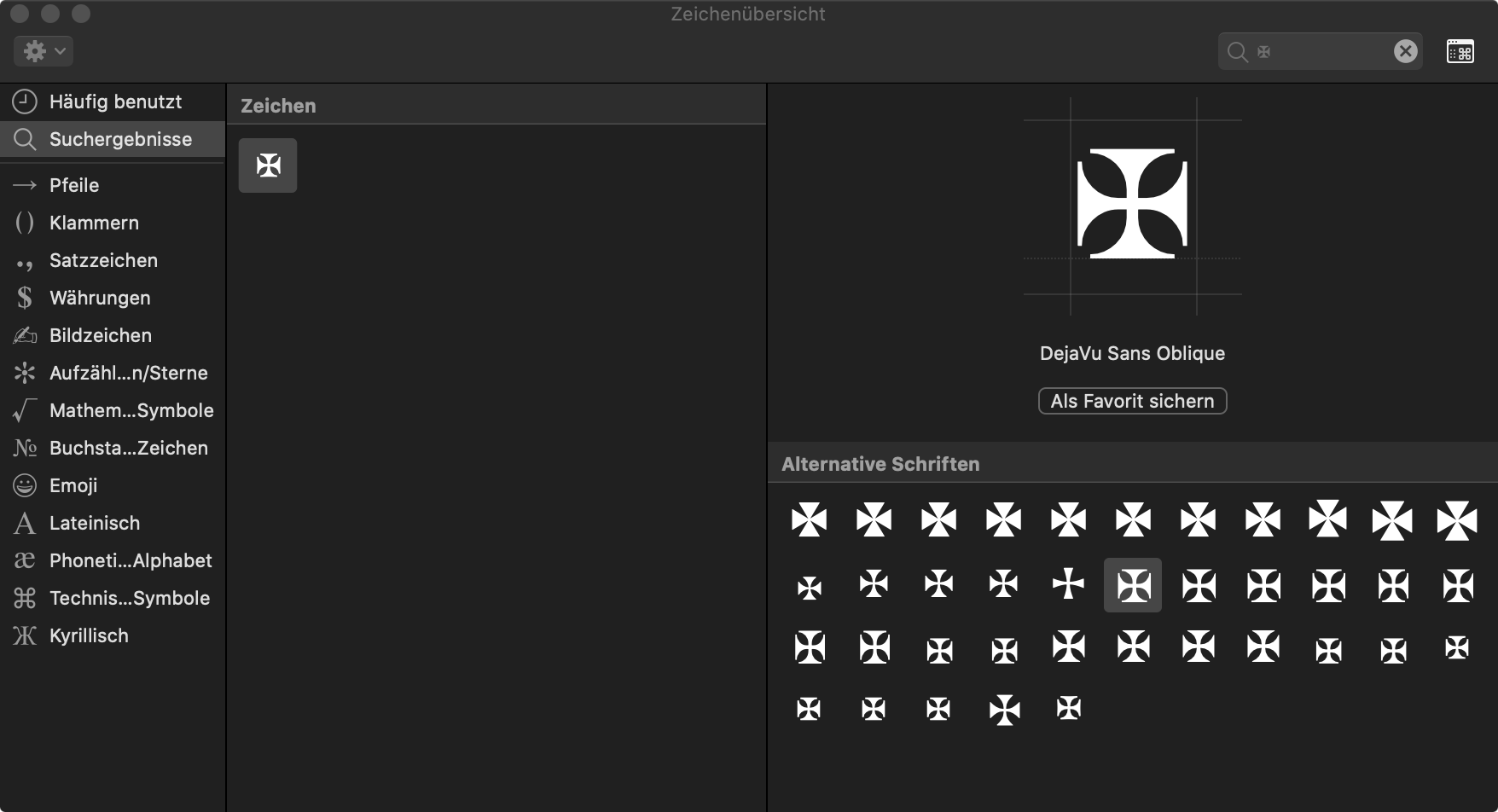- Font Squirrel relies on advertising in order to keep bringing you great new free fonts and to keep making improvements to the web font generator. If you are seeing this message, you probably have an ad blocker turned on. Please consider disabling it to see content from our partners.
- This keyboard layout is designed for Maltese. It includes an on screen keyboard which can be viewed by clicking on the Keyman icon and selecting the On Screen Keyboard menu item. The keyboard layout follows the Windows Vista Maltese 48-key layout.
- Modern versions of many fonts such as Times New Roman, Arial, Verdana, Tahoman Times CE (Mac OS X) or Palatino (Mac OS X) are Unicode fonts and contain the letters needed for this language. It is recommended you transistion to the newer Unicode fonts whenever possible. Windows Accent Codes & Utilities Windows Maltese.
The above test file correctly renders a maltese cross dingbat using the Zapf Dingbats font, using prince 6.x on Mac OS X.
On my Linux box, I installed the ITC Zapf Dingbats font from http://fonts.com/ (along with some other non-symbol fonts). The other fonts (e.g. Sabon, etc.) work just fine with prince 5.1 and 6.x.
I can verify that Zapf Dingbats is installed under that name:
fc-list | grep -i ding
Webdings:style=Regular
Dingbats:style=Regular
Caladings CLM:style=Regular
Zapf Dingbats:style=Regular
Yet when I use prince to render the test on Linux, I get this error:
prince: warning: no glyphs for character U+2720, fallback to '?'
(And of course a ? appears in place of the intended glyph.)
Could it be that the .ttf version of Zapf Dingbats sold by http://fonts.com/ does not contain the entity encodings required to map Unicode dingbats to the proper glyphs? If so,
1) What is the solution for rendering this glyph?
2) What is the recommended way of inspecting the capabilities of .ttf fonts on the Linux side? Does Prince have any debugging options that will help troubleshoot the font environment?
-c
- Macintosh Extended Keyboard Accent Codes
- HTML Entity Codes
- Language Codes: mt
About Maltese
Maltese (Malti), an official language of the European Union, is a form of Arabic spoken on the island of Malta, but written in the Western Roman alphabet. In addition, it's grammar is different from Modern Standard Arabic.
Maltese Links
- Wikipedia (some text disputed, but includes links and bibliography)
Nexa is a Sans-Serif typeface font designed by Svetoslav Simov and published by Fontfabric Type Foundry in 2012. With 232 number of characters and 9 weights, Nexa is a unique and elegant typeface. In the free version of nexa font, you will find Nexa Bold Font, Nexa Light Font. Download free font from EagleFonts.com. Download free TrueType Foreign Language Fonts. Available in TrueType (.TTF) format for Windows & Mac. Preview.ttf font by typing your own text. Biggest searchable database of free TrueType fonts.
Fonts for Dotted Consonants

Maltese Dotted Consonants
Maltese is written in the Roman alphabet but includes dotted consonants and barred h. These symbols require Unicode support apart from that of other Western European languages.
Unicode Fonts
Modern versions of many fonts such as Times New Roman, Arial, Verdana, Tahoman Times CE (Mac OS X) or Palatino (Mac OS X) are Unicode fonts and contain the letters needed for this language. it is recommended you transistion to the newer Unicode fonts whenever possible.

Windows Accent Codes & Utilities
Windows Maltese Keyboard
As of Windows XP Microsoft provides a Maltese keyboard utility which allows you to type dotted consonants. If you wish to simulate a Maltese keyboard, do the following:
- Go to Start then Control Panels then Regional and Language Options. Follow the instructions for Activating the Language Bar
- While in the Regional and Language Options control panel, click on the Languages tab, then the Details button.
- Click the Add button and select Maltese from the Input Language dropdown menu.
- Click OK to close all windows and save changes.
Additional Information
- See the University of Malta Enabling Maltese in Windows for complete instructions with screen captures OR
- SeeDetailed Instructions for more detailed instructions with screen capture images. See the Micorosoft Keyboard Layouts for the position of the keys.
Character Map
Another method is to use the Character Map utility to insert individual characters as needed.
Windows Alt Codes (Word 2003/2007)
If you are using a recent version of Microsoft Word (2003+), you can use the following ALT key plus a numeric code can be used to type a Latin character (accented letter or punctuation symbol) in any Windows application.
Notes on the Codes
- These work only in Microsoft Word 2003 and above
- You must use the numeric keypad. More detailed instructions about typing accents with ALT keys are available.
- The font in your document must be set to one that includes these characters.
- If this is not available, you can use the Character Map to insert the characters in a master document, then cut and paste as needed.
Maltese Word 2003/2007 ALT Codes
| Let | ALT Code |
|---|---|
| Ċ | ALT+0266 capital C dot |
| Ġ | ALT+0288 capital G dot |
| Ħ | ALT+0294 capital H bar |
| Ż | ALT+0379 capital Z dot |
| Let | ALT Code |
|---|---|
| ċ | ALT+0267 lower C dot |
| ġ | ALT+0289 lower G dot |
| ħ | ALT+0295 lower H bar |
| ż | ALT+0380 lower Z dot |
NOTE: Codes with numbers over 255 are only available in Word 2003/2007. Users with older versions of Windows or not using may need to use the Character Map utility.
Macintosh OS X Accent Codes
OS X and Extended Keyboard
For Unicode Compliant Applications, you can activate the U.S. Extended keyboard (10.3/10.4) or the Extended Roman keyboard (10.2) to type Maltese letters.
Maltese Extended Keyboard Codes
| ACCENT | SAMPLE | TEMPLATE |
|---|---|---|
| Dot Above | Ċ,ċ | Option+W, X |
| Barred H | Ħ,ħ | Option+L, h |
Example 1: To input the lower case ċ (C-dot) hold down the Option key, then the W key. Release both keys then type lowercase c.
Example 2: To input the capital Ħ, hold down the Option key, then the L key. Release both keys then type capital H.
Third Party Keyboard
A third party freeware Maltese keyboard is also available from Frogbat.com.
Browser Setup
Recommended Browsers
For dotted consonants, the following browsers have the most consistent results.
Test Site
Many sites from Malta are written in English. The following is a link to the Maltese Wikipedia
HTML Accent Codes
Maltese Encoding and Language Tags
These are the codes which allow browsers and screen readers to process data as the appropriate language. All letters in codes are lower case.
- Encoding:utf-8(Unicode)
- Language Codes: mt
See Using Encoding and Language Codes for more information on the meaning and implementation of these codes.
HTML Entity Codes
Below are the codes for dotted consants and barred h. For instance, if you wanted to write paġna, you would code paġna.

| Let | HTML Code |
|---|---|
| Ċ | Ċ (capital C dot) |
| Ġ | Ġ (capital G dot) |
| Ħ | Ħ (capital H bar) |
| Ż | Ż (capital Z dot) |
| Let | HTML Code |
|---|---|
| ċ | ċ (lower C dot) |
| ġ | ġ (lower G dot) |
| ħ | ħ (lower H bar) |
| ż | ż (lower Z dot) |
Using Encoding and Language Codes
Computers process text by assuming a certain encoding or a system of matching electronic data with visual text characters. Whenever you develop a Web site you need to make sure the proper encoding is specified in the header tags; otherwise the browser may default to U.S. settings and not display the text properly.
To declare an encoding, insert or inspect the following meta-tag at the top of your HTML file, then replace '???' with one of the encoding codes listed above. If you are not sure, use utf-8 as the encoding.
Generic Encoding Template
<head>
<meta http-equiv='Content-Type'>
...
<head>
Declare Unicode
<head>
<meta http-equiv='Content-Type'>
...
<head>
XHTML
The final close slash must be included after the final quote mark in the encoding header tag if you are using XHTML
Declare Unicode in XHTML
<head>
<meta http-equiv='Content-Type'U T F dash 8'>utf-8' />
...
<head>
No Encoding Declared
If no encoding is declared, then the browser uses the default setting, which in the U.S. is typically Latin-1. Some display errors may occur.
Language Tags
Language tags are also suggested so that search engines and screen readers parse the language of a page. These are metadata tags which indicate the language of a page, not devices to trigger translation. Visit the Language Tag page to view information on where to insert it.
Links

Maltese Links
- Wikipedia (some text disputed, but includes links and bibliography)
Maltese Fonts For Mac Download
Maltese Computing
Maltese Fonts For Mac Pro
 [an error occurred while processing this directive]
[an error occurred while processing this directive]